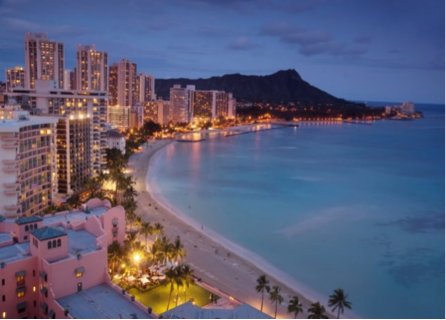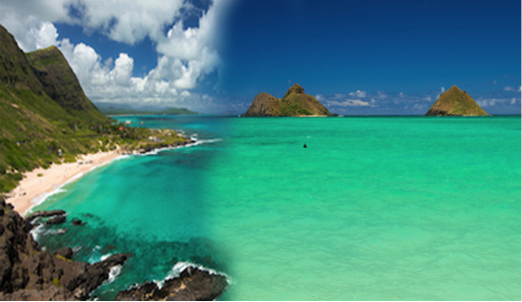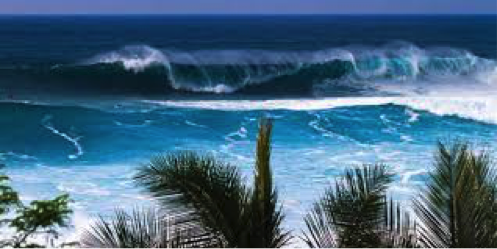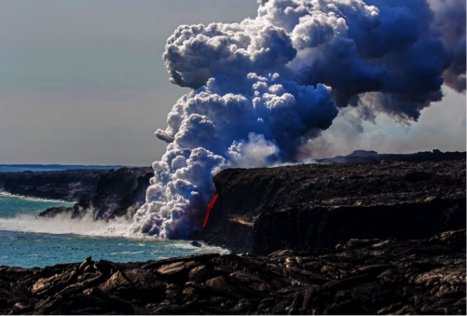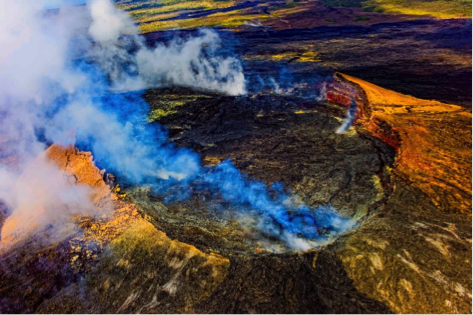
Official Language: Hawaii is the only American state to have two official languages, Hawaiian and English. However, a 3rd unofficial language is also widely spoken, Pidgin which is a slang combining words from many aspects of island life and culture.
Hawaii is a state of the United States of America located in the Pacific Ocean. It is the only U.S. state located outside North America and the only island state. The state encompasses nearly the entire Hawaiian archipelago, 137 islands spread over 1,500 miles.
There are six major islands to visit in Hawaii: Kauai Oahu, Molokai, Lanai, Maui, and the island of Hawaii. Each has its own distinct personality, adventures, activities, and sights.
Kauai:
Kauai is Hawaii’s fourth largest island and has been called “Garden Island”. Kauai is the oldest and northernmost island of the Hawaiian island it is immersed with emerald valleys, sharp mountain spires and jagged cliffs aged over time and the elements. Over time the island has formed tropical rainforests, rivers, and cascading waterfalls. Certain parts of the island are only accessible by air or sea, but the views go beyond your imagination.
On Kauai you can kayak on the Wailua River, snorkel on the Poipu Beach, hike in the Kokee State Park, or zipline above the island’s lush valleys. But the island’s laid-back atmosphere and rich culture in the small towns is what makes Kauai a timeless place to visit.
Oahu:
Oahu has been called “The Gathering Place” and lives up to its name. The third largest Hawaiian island. Oahu is a diverse population. A mix of East and West cultures and rooted in the values and traditions of the Native Hawaiian people. From bustling city life to a laidback surf town Oahu shows its contrast between ancient and modern making discovering the island an adventure.
Molokai:
Hawaii’s fifth largest island is only 38 miles long and 10 miles across but is home to the highest sea cliffs in the world. Molokai remains true to its roots with a large percentage of the population being of Native Hawaiian ancestry who continue to preserve their rural lifestyle. Molokai boost an outdoor adventure where you can enjoy Papohaku Beach, one of Hawaii’s largest white-sand beaches, or Kalaupapa National Historical Park.
Lanai:
Hawaii’s smallest inhabited island offers big adventure. Nine miles from Maui but a world apart, Lanai makes you feel like you are in two different worlds. One consists of the luxuries found in a resort where you can enjoy world-class amenities and championship-level golfing. While the other is a 4-wheel drive, off the beaten path treasure hunt. Lanai is where you can find serenity, adventure, and privacy on any of the three regions.
Maui:
Known as “The Valley Isle” Maui is the second largest Hawaiian island. It is loved for its world-famous beaches, views of migrating humpback whales, during the winter months, farm-to-table cuisine and the splendid sunrise and sunset from Haleakala.
Island of Hawaii
Hawaii is the youngest and largest of the islands. It is almost twice as big as all the other Hawaiian Islands combined, giving it the nickname “The Big Island”. You can encounter all but four the world’s different climates, from wet tropical to polar tundra which is a result of the effects and elevations of the massive volcanoes Maunakea and Maunaloa. Experience geological features at Hawaii Volcanoes National park, the snow-capped heights of Maunakwa, the lush valleys of the Hilo and Hamakua Coasts, to the jet-black sans of Punaluu Beach.
Hawaiian Arts & Culture: The Expression of Aloha
The oldest of Hawaiian chants describe the Hawaiian Islands. The spirits that inhabit them, the forces of nature that shaped them and all living things upon them. This is a sense of connection that is the foundation of the Hawaiian culture. Understanding that we all have a duty to Malama, to take care of the environment for one another.
The spirit of aloha, being in the presence of and sharing the essence of life, teaches us lessons of kindness, peace, compassion, and responsibility to future generations. These lessons are expressed through chants, music, hula, arts and cultures through the warm greetings and Hawaiian hospitality
Native Hawaiian Traditions
1. The honi ihu, or the touching of noses, is a traditional method of greeting one another, whether it is a man and woman, two men or two women. It allows both people to exchange breath, which is the supremely important life force in Hawaiian understanding and share scents and convey a closeness in relationship.
2. Made from flowers, bird feathers, shells, seeds, hair or ivory, the lei (garland or wreath) has become a symbol of Hawaii. Worn on the top of the head or around the neck, lei were used ornamentally by Native Hawaiians, especially chiefs, to signify their rank. Giving a lei was a traditional practice, but not like the ceremonious welcome practice that has become the local custom today. The manner of presenting was also different: it was tied around the neck, rather than casting the lei over the head, respecting the sacredness of a person’s head and back.
3. Hula is a complex artform performed for religious purposes, entertainment and to preserve historical events, genealogy and mythology through movements accompanied by chants. It is a sacred, serious pursuit, involving rigorous training and technical skill, and academic knowledge taught by respected kumu (teachers) who carry on and advance wisdom from a long lineage of masters. Unlike a lot of hula performed today, hula was not meant to be a spectacle, and was often performed privately.
Places To Go
- USS Arizona Memorial
he USS Arizona Memorial commemorates the lives lost in the attack on Pearl Harbor, and the historic moment that launched the United States into World War II. Upon entering the USS Arizona Memorial, you will be able to line up and receive a number which will allow you to take part in a guided tour.
- Honolulu Zoo
Honolulu Zoo offers a wild assortment of animal exhibits in an unforgettably beautiful, tropical setting. See the African Savanna, Tropical Rainforest, special pint-sized Kids Zoo and an exhibit devoted to the animals of the Pacific Islands. Pack a to-go lunch to enjoy, the Honolulu Zoo welcomes picnickers.
- Waikiki Beach
Waikiki Beach was once the playground for Hawaiian royalty; today Waikiki Beach is known the world over as one of the most beautiful sandy stretches to be found anywhere. Waikiki Beach is home to surfing, dining, and shopping plus all kinds of water sports, and is an ideal location to simply relax in the sun.
- Kealakekua Bay
Located 13 miles south of Kailua-Kona, is a pristine marine sanctuary and preservation site filled with colorful marine life and coral. Tucked along this bay are ancient religious temples and also the historic monument where world explorer Captain James Cook met his fate.
- Hawaii Volcanoes National Park
Hawaii Volcanoes National Park is on Hawaii Island (the Big Island). At its heart are the Kīlauea and Mauna Loa active volcanoes. The Crater Rim Drive passes steam vents and the Jaggar Museum, which features volcanology exhibits and a viewpoint overlooking Halema’uma’u Crater. Thick ferns mark the entrance to the Thurston Lava Tube (Nāhuku). The Chain of Craters Road weaves over lava. Trails crisscross the park.
- Diamond Head
Diamond Head is a volcanic tuff cone on the Hawaiian island of Oʻahu and known to Hawaiians as Lēʻahi. The Hawaiian name is most likely derived from lae plus ʻahi because the shape of the ridgeline resembles the shape of a tuna’s dorsal fin.
- Haleakala National Park
Haleakala National Park covers the summit area of the larger of the two volcanic mountains that make up Maui. The National Park’s boundary has fingers that extend down the Hana side of the mountain, all the way to the ocean.
In a nutshell: Haleakala Crater is the most popular attraction in Upcountry Maui. Stunning sunrises, panoramic out-of-this-world landscapes, birds-eye views of the Maui central valley, and flora and fauna that exist nowhere else in the world.
- Harbor Bay Lighthouse
There are 114 steps to the top of the lighthouse. On the way up, you can stop to look at many of the historical relics and photos on the walls

